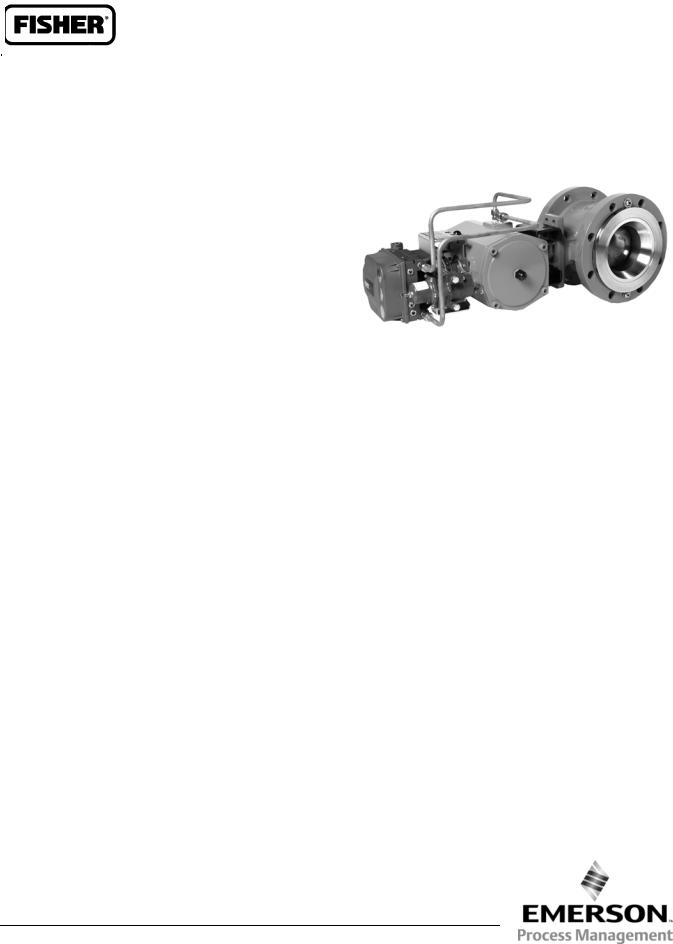Emerson Fisher Vee-Ball V150, Fisher Vee-Ball V150S Data Sheet

Slurry Vee-Ball Valve |
Product Bulletin |
51.3:V150S |
|
D103154X012 |
February 2013 |
|
|
Fisherr V150S
Slurry Vee-Ball™ Control Valve
The Fisher V150S Slurry Vee-Ball valve mates with CL150 raised face flanges. Rugged construction, highly wear-resistant trim materials, and an unrestricted straight through flow path make the design ideal for controlling the most abrasive of slurries.
A shaft with a choice of drive connections will allow a variety of power operated actuators and valve positioners or controllers to be used.
W8512
The design is particularly effective in minimizing erosive damage to the adjoining pipework, thereby providing greater operational safety and service life when compared with other valve types.
Features
Fully protective trim–The valve body, shaft, and bearings are fully protected by hard wear-resistant trim materials.
Pipeline and flange protection–The throttled flow stream is guided through a specially shaped flow ring to minimize turbulence and impingement on the pipe wall. The valve can be matched to the bore size of the inlet and outlet piping in order to prevent turbulence being generated by the step resulting in scouring erosion of the flange faces, unexpected leakage, and expensive rework. In addition, both the inlet and outlet valve flange faces are protected by a portion of the hard trim.
Fisher V150S Slurry Vee-Ball Control Valve
Long Service Life–The Vee-Ball design, when used in reverse flow mode, keeps the high velocity down stream of the vena contracta within the flow ring bore at the outlet of the valve. Compared with other styles of valves, the exit flow is essentially parallel with the flow ring wall and a minimum of flow impingement occurs. Combined with a choice of hard wear-resistant materials, a significantly long life is obtained.
Easily replaceable trim parts allow the valve to be overhauled at predetermined intervals and the valve body used again during repeated operational cycles.
Ease of installation–Full flanging on the valve body allows the valve body to be easily aligned centrally with the pipe flanges, an essential requirement in avoiding erosion across the flange faces.
Excellent Flow Control–Precise contouring of the V-notch ball provides a modified equal percentage flow characteristic. When combined with a valve actuator/controller system having minimal lost motion, improved process control can be obtained.
(continued on page 2)
www.Fisher.com

Product Bulletin |
Slurry Vee-Ball Valve |
51.3:V150S |
|
February 2013 |
D103154X012 |
|
|
Features (continued)
Quick and Easy Maintenance–All trim parts are retained without the use of press fits or screw threads exposed to the process fluid. See figure 1.
ceramic ball for particularly aggressive slurry services with extended lifetime requirements. The ceramic insert offers substantial increase in flow ring lifetimes.
Structural Integrity–The valve body, complete with flanges, is made from a one-piece casting. No welding is employed. No O-ring seals are used. Use of a flanged valve body does not require the use of extra long studs.
The shaft seal is made from well-proven PTFE chevron ring packing with the means for external adjustment.
Options
A PSZ (partially stabilized zirconia) ceramic flow ring insert is available with HCI (high chrome iron) or PSZ
Trim materials are available to meet the requirements of corrosive/erosive slurries. See table 2.
The “Flow Over the Top” V-Notch Ball offers an alternative to the standard V-Notch Ball in scaling applications.
The drive shaft is available with either a double D or splined actuator connection to accommodate a choice of actuation between a spring-opposed diaphragm or a rack and pinion.
2

Slurry Vee-Ball Valve |
Product Bulletin |
51.3:V150S |
|
D103154X012 |
February 2013 |
|
|
Specifications
Valve Sizes |
Flow Direction |
|
J NPS 3, J 4, J 6, J 8, J 10, and J 12 |
Reverse flow recommended (into concave face of |
|
End Connection |
ball, out through the flow ring) |
|
|
||
V150S: CL150 Raised-face flange |
Flow Coefficients |
|
Face to Face Dimension |
See Fisher Catalog 12 |
|
|
||
See figure 2 |
Maximum Ball Rotation |
|
|
||
Maximum Inlet Pressure |
90 degrees |
|
Consistent with pressure-temperature ratings per |
Valve Installation |
|
ASME B16.34 but do not exceed the material |
||
temperature capabilities shown below or the pressure |
Shaft axis to be horizontal |
|
drop limitations |
|
|
Maximum Shut Off Pressure |
Actuator Mounting |
|
Right-hand or left-hand, as viewed from upstream |
||
See tables 3 and 4 |
||
end of valve |
||
|
||
Shutoff Classification |
Valve/Actuator Action |
|
Class I per ANSI/FCI 70-2 and IEC 60534-4 |
||
With diaphragm or piston rotary actuator and splined |
||
(Class II and better not available). A defined initial |
||
maximum leak rate can be provided subject to review |
shaft, the valve is field-reversible between PDTC or |
|
of service conditions. |
PDTO: J push-down-to-close (extending actuator |
|
|
rod closes valve) and J push-down-to-open |
|
Construction Materials |
(extending actuator rod opens valve) |
|
Standard Construction: See table 1 |
Actuator Size Selection |
|
|
||
Temperature Capability |
Contact your Emerson Process Management sales |
|
|
||
For Trim 1: 427_C (801_F) maximum |
office for information |
|
For Trims 2 and 3: 230_C (446_F) maximum |
|
|
For materials: See table 1 |
Approximate Weight |
|
|
||
Flow Characteristic |
NPS 3: 15 kg (33 lb) |
|
NPS 4: 28 kg (62 lb) |
||
Approximately equal percentage |
||
NPS 6: 45 kg (99 lb) |
||
|
||
Dimensions |
NPS 8: 82 kg (180 lb) |
|
NPS 10: 120 kg (265 lb) |
||
See figures 2 and 3 |
||
NPS 12: 178 kg (390 lb) |
||
|
|
3
